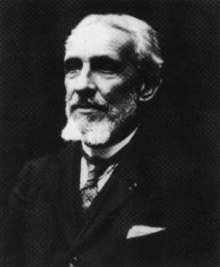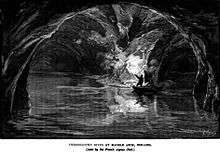Édouard-Alfred Martel
Édouard-Alfred Martel (1 July 1859, Pontoise, Val-d'Oise – 3 June 1938, Montbrison), the 'father of modern speleology',[1] was a world pioneer of cave exploration, study, and documentation. Martel explored thousands of caves in his native France and many other countries, popularised the pursuit of cave exploration, introduced the concept of speleology as a distinct area of scientific study, maintained an extensive archive, and in 1895 founded Société de Spéléologie,[2] the first organisation devoted to cave science in the world.
Édouard-Alfred Martel | |
|---|---|
 | |
| Born | 1 July 1859 |
| Died | 3 June 1938 (aged 78) Montbrison |
| Known for | Father of modern speleology |
| Awards | Legion of Honour |
Life and Exploration
No man has gone before us in these depths, no one knows where we go nor what we see, nothing so strangely beautiful was ever presented to us, and spontaneously we ask each other the same question: are we not dreaming?
— É.-A. Martel, "Les causses du Languedoc", Conférences de l'exposition universelle internationale de 1889[3]
Édouard-Alfred Martel was born in Pontoise, Seine-et-Oise on 1 July 1859. Born into a family of lawyers, he studied at the Lycée Condorcet in Paris. Early on, he became passionate about geography and the natural sciences and in 1877 he won first prize in an open competition for geography. He was a great reader of the works of Jules Verne. In 1866, while holidaying with his parents, he visited the Caves of Gargas in the Pyrenees. Other trips allowed him to travel to Germany, Austria and Italy. In 1879, he visited Postojna Cave in Slovenia, an extensive cave system.
%2C_maison_natale_d'%C3%89douard-Alfred_Martel_(1859-1939)%2C_1_rue_de_la_for%C3%AAt_Hardelot.jpg)
In 1886, after completing his military service, he earned a law degree and became a licensed attorney with the Commercial Court of the Seine. Martel devotes his leisure and holiday time to travels across France. From 1883, he conducts work on the karstic plateaus of the Causses, shaped by the gorges of the Tarn, Jonte, Dourbie and Lot.
In June 1888, he began his caving career in the Bramabiau gorge in Gard. He and several companions entered a rock cavity where a stream known as Bonheur sinks and reappears farther along the Bramabiau Gorge. That same June with the same team he explored the Dargilan Cave along the Jonte Gorge over a mile away. In 1889 he visited Padirac Cave, near Gramat. He climbed down the entrance chasm and reached an underground river at a depth of 100m. Martel and his cousin Gaupillat set off to explore with a canoe, discovering two kilometres of new passage. Martel later bought the Padirac Cave, and turned it into a show cave.
In July 1890 he married Aline de Launay, sister of Louis de Launay, a professor of geology and future member of the Academy of Sciences. Collaboration with Louis de Launay provide a scientific basis for some of Martel publications, including articles in the journal La Nature, which Martel and Launay were later editors. In 1894, he published The Abyss, a book in which he describes the wonders of the underworld he discovered and visited during the six seasons of exploration he undertook from 1888 to 1893. During this period, he visited and indexed more than 230 caves.
In 1895, he ventured further afield and organised an expedition to Ireland and England. He discovered the underground lake of Marble Arch in Northern Ireland. In Yorkshire he made the first complete descent, after a partial descent by Englishman John Birkbeck in 1842, into the pothole of Gaping Gill. He reached the Main Chamber, 170 feet lower than Birkbeck had ventured.[4] That same year, he founded the Speleological Society and starts a periodic newsletter, Spelunca.

In 1896, he was invited by the Archduke Luis Salvator, a cousin of Emperor Franz Joseph of Austria, to visit their country. With his foreman and journeyman Louis Armand, he explored several caves on the island of Mallorca. In the Cave of Drach near Porto Cristo he discovered the largest underground lake known at the time.
Martel's explorations intensified around this time. His priority is to explore the caves of Causses. He also explored the caves and caverns of the limestone regions of Savoie, Jura, Provence and the Pyrenees. He traveled throughout Europe, Belgium, Dalmatia, Bosnia and Herzegovina, Montenegro, where he investigated the course of the Trebišnjica, considered the one of the longest underground rivers in the world. In 1899 he finally left professional life to devote himself to his scientific research. He served as editor of La Nature from 1905 to 1909 and was a member of the Société de géographie, of which he was elected president. In 1912, he spent three days exploring in Mammoth Cave, Kentucky where he undertook scientific work including barometric determinations of the elevations of the cave's different levels. Martel was active in cave exploration from 1888–1914, recording some 1,500 caves during this time.[5]
Edward Alfred Martel died 3 June 1938 in St Thomas Guard, near Montbrison in the Loire.
Speleology
Throughout his life, Martel strongly promoted the study of speleology, striving to increase its recognition as a scientific field. In his own work, he published some 20 books and 780 articles during the course of his career.[5] At least 53 of his articles were published outside France and several of these were translated into foreign languages. He also made regular trips abroad to conduct lectures on speleological subjects.[5]
Société de Spéléologie
In 1895 in Paris, Martel founded the Société de Spéléologie, a scientific organisation which would regularly publish articles on speleology in its periodical, Spelunca. The formation of this society was one of the means by which he was able to turn speleology into an internationally recognised science, with many foreign authors publishing articles, many French authors publishing articles on foreign caves and with the society growing to include 33% foreign members by 1909.[5]
Bibliography
Martel wrote many books and articles about speleology, hydrology and geology, of which the most notable are listed here:[6][7]
Books
- Les Cévennes (in French), Paris: Delagrave, 1890, 400 p. (12 editions)
- Les Abîmes (in French), Paris: Delagrave, 1894, ISBN 2-7348-0533-2, 580 p. (10 editions)
- Le massif de la Bernina (in collaboration with Lorria, A.) (in French), Zürich: Orell, 1895, 200 p.
- Irlande et cavernes anglaises (in French), Paris: Delagrave, 1897, 400 p.
- Le Trayas et L'Estérel (in French), Paris: Delagrave, 1899, 80 p.
- La Spéléologie (in French), Paris: Carre et Naud, 1900, 125 p.
- Le gouffre et la rivière souterraine de Padirac (in French), Paris: Delagrave, 1901, 180 p.
- La Photographie souterraine (in French), Paris: Gauthier-Villars, 1903, 70 p.
- La spéléologie aux XXe siècle (in French), Paris: Hermann, 1905, 810 p.
- Le sol et l'eau – Traité d'hygiène (in collaboration with de Launay, Ogier and Bonjean) (in French), Paris: Baillere, 1906, 486 p.
- L'évolution souterraine (in French), Paris: Flammarion, 1908, 388 p.
- La Côte d'azur russe: Riviera du Caucase (in French), Paris: Delagrave, 1909, 423 p.
- Les cavernes et les rivières souterraines de la Belgique (Van den Broeck, E, Martel, E.-A. and Rahir, Ed.) (in French), Bruxelles: Lamertin, 1910, (2 vol.) 1800 p.
- Explications sur Mammoth Cave (in French), 1914
- Nouveau Traité des eaux souterraines (in French), Paris: Doin, 1921, 840 p.
- Les causses et gorges du Tarn (in French), Millau: Artieres et Maury, 1926, 512 p.
- L'Aven Armand (in French), Millau: Artieres et Maury, 1927, 48 p.
- La France ignorée (2 vol.) (in French), Paris: Delagrave, 1928–1930, 600 p.
- Les Grands Causses (Les Causses majeurs) (in French), Millau: Artières et Maury, 1936, 510 p.
Articles
- "Le Cañon du Tarn", Annuaire du Club Alpin Français (in French), 1883
- "Le Causse Noir et Montpellier-le-Vieux", Annuaire du Club Alpin Français (in French), 1884
- "Sous Terre", Annuaire du Club Alpin Français (in French), Paris: Club alpin français, 1888
- "Les causses du Languedoc" (PDF). Conférences de l'exposition universelle internationale de 1889 (in French). Paris. 5 September 1889. Retrieved 30 July 2012.
- "Sur la température des cavernes", Comptes rendus de l'Académie des sciences (in French), 118: 615–617, 1894
- "Sous Terre (8e campagne) Marble Arch, Irlande et Gaping Ghyll, Angleterre", Annuaire du Club Alpin Français (in French), Paris: Club alpin français, 22: 171–209, 1895, retrieved 29 July 2012
- "Sur le gouffre de Gaping-Ghyll (Angleterre)", Comptes rendus de l'Académie des sciences (in French), 122: 51–53, 1896
- "Sur quelques anomalies de la température des sources", Comptes rendus de l'Académie des sciences (in French), 122: 97–99, 1896
- "Sur des observations d'hiver dans les cavernes des Causses (Padirac, etc.)", Comptes rendus de l'Académie des sciences (in French), 122: 903–905, 1896
- "Sur les siphons des sources et des rivières souterraines", Comptes rendus de l'Académie des sciences (in French), 122: 1147–1150, 1896
- "Sur la Cueva del Drach (Grotte du Dragon) dans l'île Majorque", Comptes rendus de l'Académie des sciences (in French), 124: 1385–1388, 1897
- "Sur l'hydrographie souterraine et les chouruns du Dévoluy (Hautes-Alpes)", Comptes rendus de l'Académie des sciences (in French), 124: 1170–1173, 1897
- "Sur la contamination de la source de Sauve (Gard)", Comptes rendus de l'Académie des sciences (in French), 125: 897–900, 1897
- Martel, É.-A.; Viré, A. (1897), "Sur l'aven Armand (Lozère) (profondeur 207 m)", Comptes rendus de l'Académie des sciences (in French), 125: 622–625
- "British Caves and Speleology", The Geographical Journal, X (5): 500–511, 1897, doi:10.2307/1774383, retrieved 24 July 2012
- Spelunca, Paris, 74 Missing or empty
|title=(help)
See also
References
- Kliebhan, Bernd, History of Cave Research: E. A. Martel 1859–1938, archived from the original on 2007-10-23, retrieved 2009-04-04
- "Brève histoire de la spéléologie", Histoire (in French), Fédération Française de Spéléologie, archived from the original on 2011-07-20, retrieved 2009-04-05 External link in
|publisher=(help) - Martel, É.-A. (5 September 1889). "Les causses du Languedoc" (PDF). Conférences de l'exposition universelle internationale de 1889 (in French). Paris. Retrieved 30 July 2012.
Nul être humain ne nous a précédé dans ces profondeurs, nul ne sait où nous allons ni ce que nous voyons, rien d’aussi étrangement beau ne s’est jamais présenté à nos yeux, ensemble et spontanément nous nous posons la même question réciproque : est-ce que nous ne rêvons pas ?
- Martel, É.-A. (1897). "British Caves and Speleology". The Geographical Journal. X (5): 500–511. doi:10.2307/1774383. Retrieved 24 July 2012.
- Shaw, T. R. (1988). "Martel's visit to Mendip in 1904: part of his international strategy?" (PDF). Proceedings of the University of Bristol Spelæological Society. 18 (2): 278–291. Retrieved 29 July 2012.
- Publications from E. A. Martel, archived from the original on 2007-10-23, retrieved 2009-04-04
- Schut, Pierre-Olaf (2006), "E. A. Martel, the traveller who almost became an Academician" (PDF), Acta Carsologica, Ljubljana, 35 (1): 149–157, doi:10.3986/ac.v35i1.252, retrieved 2009-04-05
Further reading
- André, Daniel; et al. (1997), La Plume et les Gouffres
- André, Daniel; Gautier, Alain (1995), "La Societe de Speleologie", Spelunca, 60: 11–18
- Casteret, Norbert (1943), E.-A. Martel, Explorateur du Monde Souterrain, Paris: Gallimard
- Chabert, Claude; Courval, Michel de (1971), E. A. Martel 1859–1938
- Kliebhan, Bernd (1999), "The contribution of E.A. MARTEL (1859–1938) to the development of caving technique", Mitt. Verb.dt.Höhlen- u. Karstforsch. Jg., 45 (2), retrieved 24 July 2012
- Roberts, E. E. (1947), "Edouard Alfred Martel (1859–1938)", Yorkshire Ramblers' Club Journal, Leeds: Yorkshire Ramblers' Club, 7 (24): 105–116, retrieved 24 July 2012
- Shaw, T. R. (1992), "E. A. Martel", History of Cave Science: the exploration and study of limestone caves to 1900 (2nd ed.), Sydney: Sydney Speleological Society, pp. 48–51